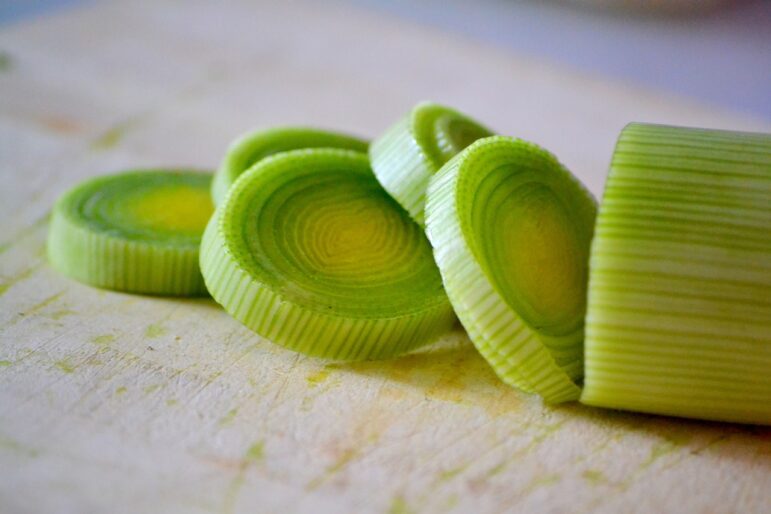
Spring has sprung and green shoots are poking their heads out of the earth, so it seems like a good time to celebrate the humble leek – the first green vegetable of the year and an important staple in our early ancestors’ diets.
Leeks have a surprisingly magical history, and not just in Wales, where you might expect it, being their national vegetable. One of the first vegetable crops grown in the fertile crescent (the origins, as we covered in last month’s article on lentils, of agriculture and settled society), leeks became an important source of fibre, vitamins, and minerals for the majority of the population. Their ubiquity across Eurasia led to them acquiring both medicinal and metaphysical connotations, from the positive to the aversive.
A pile of leeks [public domain]
For the Akkadians, the strong smell of a leek eater’s breath offended the gods, and therefore made such a person unclean and unfit to enter their temples. For Hekate and her train of spirits, on the other hand, that smell was a powerful draw, with leeks taking an integral place on the offering plate during her monthly Deipnon, a festival where Ancient Greek householders laid out a supper for the abandoned and unclaimed dead.
Where you might think this cthonic association marked leeks as unclean or unsafe for living, in fact the opposite was true; in Greece and later Rome, leeks were also the food of love, boosting desire, female fertility, and assisting in childbirth too. There was even a minor goddess, Porrima, named for the leek, who was appealed to in order to safeguard against a breech birth and ensure a safe delivery.

The Reeve, from an illustration in the Ellesmere manuscript of The Canterbury Tales, c. 1400 [public domain]
It’s when we reach the Teutonic parts of Europe that the magical properties of the leek truly come into their own. As in Greece and Rome, leeks were associated with fertility, and especially lust, to the extent that later German Christian writers railed against the vegetable and its detrimental effect on chastity. This association is largely down to the doctrine of signs and the obvious visual metaphor, boosted by the leek’s green colour (green, due to its connection with youth and new growth, was also associated with lust and fertility). We can see this association still going strong in 14th century England, when Chaucer’s Reeve uses the leek as a bawdy metaphor in his prologue:
For in oure wyl ther stiketh evere a nayl,
To have an hoor heed and a grene tayl,
As hath a leek; for thogh oure myght be goon,
Oure wyl desireth folie evere in oon.
For whan we may nat doon, than wol we speke;
Yet in oure asshen olde is fyr yreke.
(For in our will there sticks ever a nail,
To have a white head and a green tail,
As a leek has; for though our power is gone,
Our will desires folly continually.
For when we can not do anything, then will we talk about it;
Yet in our old ashes fire is raked over. )-“The Reeve’s Prologue,” Canterbury Tales lines 3877-3882, from Harvard’s Geoffrey Chaucer site
Beyond the phallic associations, however, both the Norse and the English believed that leeks had healing properties, that they could be used to treat respiratory infections and infected wounds, and could heal internal injuries when added to a broth. The Norse assigned the leek greater powers even still; according to the Poetic Edda’s “Sigrdrífumál,” leek, when dropped whole into a horn or cup of mead, had the ability to shield the drinker from being ensorcelled by any runes or spells that had been cast into the drink.
Then there are the golden bracteates, a kind of protective amulet, and knife handles unearthed in various parts of Scandinavia that have the runic inscription for leek engraved on them. Believed to have been predominately worn by women, the bracteates are predominantly found in Denmark, while the knives have been found further afield. Used for domestic tasks like scraping animal hides, it is believed that these knives were also solely used and owned by women because of the shared inscriptions with the women-associated bracteates.
The leek inscriptions on these items came in several forms, sometimes paired with other words (often the word for linen, which was also associated with fertility), sometimes alone, and sometimes shortened to a single letter l. What’s interesting about that is that the single l can also represent the term alu, a word that signified protection, and the runic term for leek may have been used as a stand in for alu when used in runic magic. It’s possible that the bracteates were intended to enhance the wearer’s fertility, provide them with protection from poison or dark magic as in the leek dropped into the horn of ale, or to provide a broader field of protection via invoking the alu.
Unfortunately there are no written records discussing the bracteates, or use of the runic l on women’s amulets and knives, so we only have our best guess as to what they were intended for. Fertility is the most commonly accepted answer (especially as they have been paired with the runic inscriptions for ale and linen which were also associated with fertility), though I believe it’s possible they were meant to invoke both protection and fertility together because of the close associations between them in pre-modern societies.
Believe it or not this is only a fraction of the leek folklore out there, but I am limited in my column space, so the rest readers will have to research for themselves. In the meantime, why not try this delicious, warming stew that highlights the flavour of leeks to welcome in the early spring?

Cut leeks [Pixabay]
Leek Stew
Ingredients
2 medium or 1 large leek
2 cans of cannelini beans
4 large white potatoes (or more, who can stop you?)
Vegetable or chicken stock
Sour cream
1 teaspoon thyme
White pepper
Nutmeg
Butter
Slice the leeks into thin rounds. Other than the toughest parts, do not throw away the green parts of the leek – they’re delicious and add healthy fibre.
Fry the leeks in butter until they brown a little for some of that lovely maillard reaction flavour. Then toss in the beans, diced potatoes, stock, thyme, and spices. Start with a pinch of each and slowly add more as the flavours develop.
Simmer until the potatoes are cooked (this will vary depending on how small you’ve cut them) and finally add salt and sour cream to taste.
The Wild Hunt is not responsible for links to external content.
To join a conversation on this post:
Visit our The Wild Hunt subreddit! Point your favorite browser to https://www.reddit.com/r/The_Wild_Hunt_News/, then click “JOIN”. Make sure to click the bell, too, to be notified of new articles posted to our subreddit.